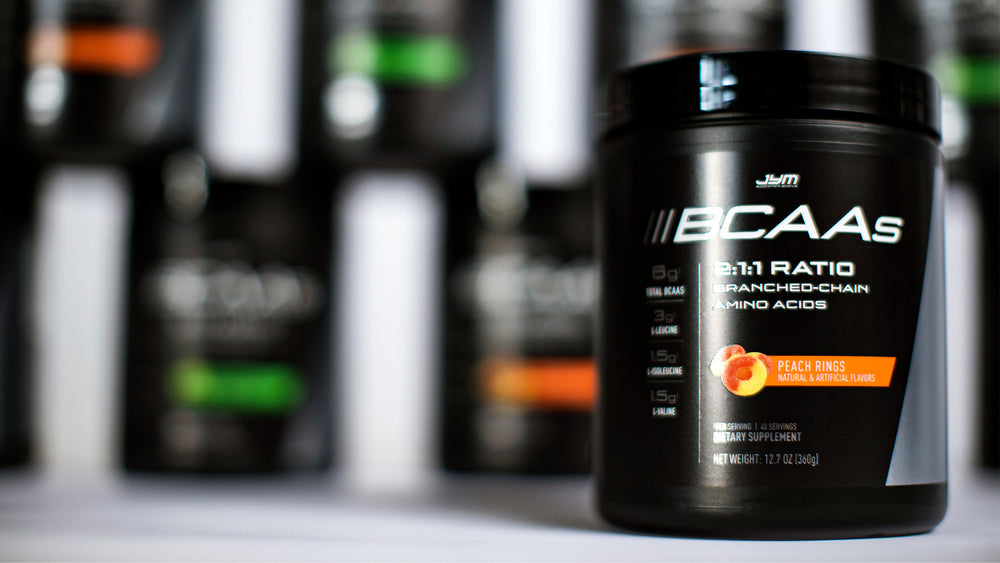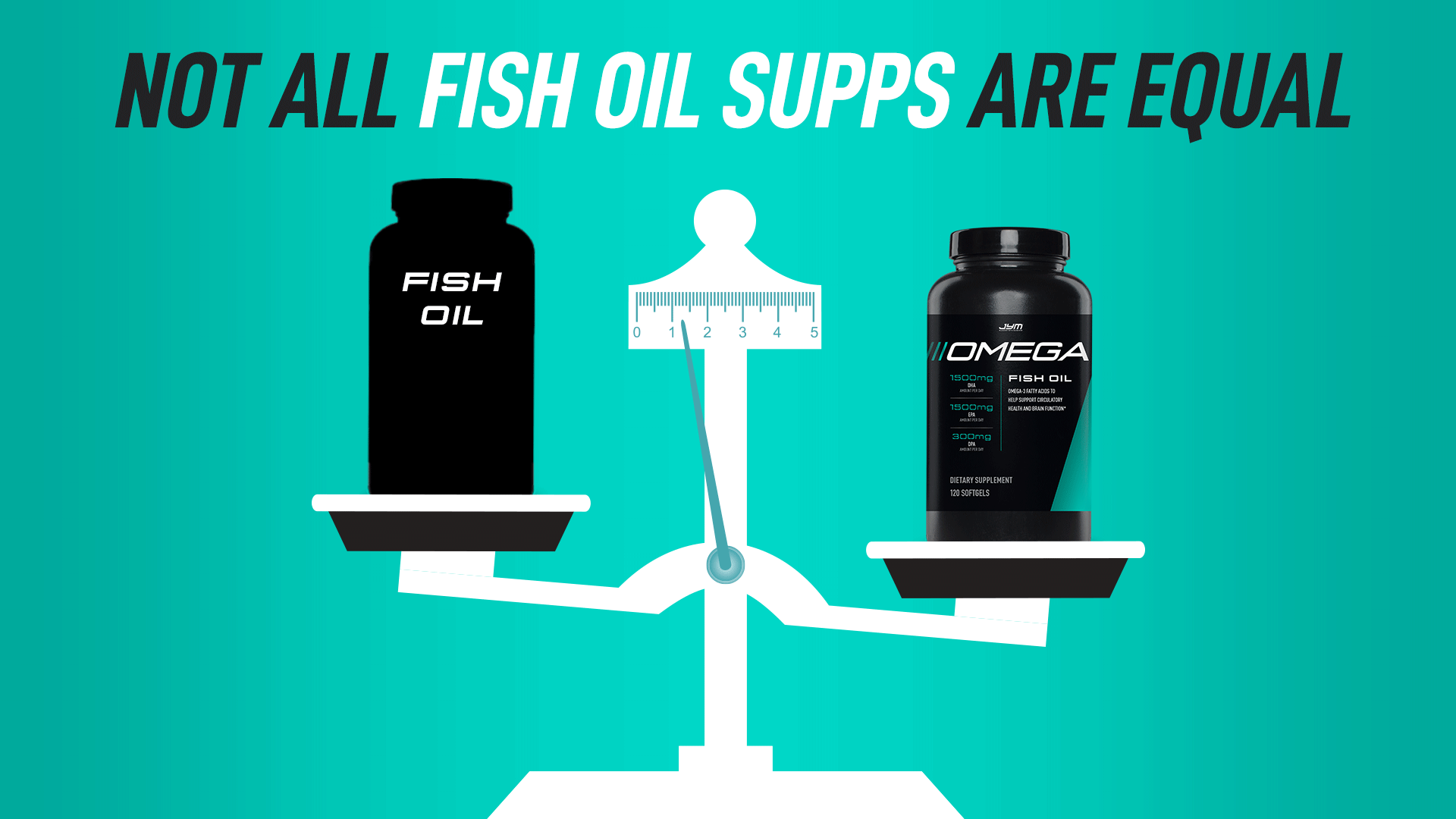Which amino acid supplement should you take to maximize muscle recovery and growth: branched-chain amino acids (BCAAs) or essential amino acids (EAAs)? I break down the science to help you decide.
There’s a passionate debate raging online and in gyms worldwide over whether it’s better to supplement with branched-chain amino acids (BCAAs) or essential amino acids (EAAs). Two seemingly similar products – both are amino acid formulas, after all – with conflicting views on their effectiveness for hard-training individuals.
Why all the conflict? Because most people engaged in the debate don’t fully understand the science behind BCAAs, EAAs, and amino acids in general. So, it’s time for some education on how these two supplements function in the body to deliver results (or not).
As you’re about to learn, for those looking to maximize muscle recovery and growth and enhance energy levels, there’s really nothing to debate.
Amino Acids 101
There are roughly 20 amino acids needed to build muscle protein. These are considered the proteinogenic amino acids, and they include: leucine, isoleucine, valine, lysine, methionine, phenylalanine, threonine, tryptophan, histidine, cysteine, tyrosine, arginine, glutamic acid, aspartic acid, serine, asparagine, glutamine, alanine, proline, and glycine.
Of these 20, the first nine are considered essential amino acids. What designates EAAs as “essential” is that our bodies don’t make them, which means we have to get them from food or supplements. (Whereas non-essential amino acids can be converted from other amino acids.)
9 Essential Amino Acids (EAAs)
-
- Leucine*
- Isoleucine*
- Valine*
- Lysine
- Methionine
- Phenylalanine
- Threonine
- Tryptophan
- Histidine
*Branched-chain amino acids (BCAAs)
Of the nine EAAs, the first three are BCAAs: leucine, isoleucine, and valine. But that doesn’t mean they’re the same as the other six EAAs. One common difference in chemical structure makes them unique, while also making them especially effective for stimulating muscle protein synthesis. Let’s get into that now…
What makes BCAAs different from EAAs?
All nine of the above amino acids are essential, but only leucine, isoleucine, and valine have the namesake branched-chain chemical structure.
No need to get too science-y here, but if you want to see what I’m talking about, I cover the chemical structure at around the 3:30 mark in the above video. Simply put, the three BCAAs are the only aminos with the “branched” V-shape structure at one end (as seen via a chemical diagram). None of the other six EAAs have those branches.
That chemical structure is significant, to say the least. An amino acid’s structure and shape determines in large part how it will be digested, absorbed, and used by the body. The important thing to know here is that the branched structure allows leucine, isoleucine, and valine to bypass the liver completely and go straight to the muscles.
This is a huge deal! All the other EAAs must pass through the liver after ingestion. Once in the liver, the body decides if it’s going to (a) send the aminos to the muscles or (b) convert those aminos to glucose for energy.
Either of these two scenarios can happen with the other six EAAs. But with the three BCAAs, only one thing can happen because they bypass the liver: leucine, isoleucine, and valine get a free pass to the muscles!
This doesn’t happen with any other amino acids, including the EAAs not named leucine, isoleucine, or valine; maybe they go to the muscles, maybe not. With BCAAs, it’s essentially guaranteed they’re going to the muscles. And once there, they can stimulate muscle protein synthesis (MPS).
The key player here is leucine. We now know that leucine ignites MPS better than any other amino acid. And we want leucine to get to the muscles and spike MPS as quickly as possible. It can do so by skipping the liver and going straight to its desired destination, the muscles.
The Problem with BCAA and EAA Research
Now that you understand amino acids a little better, it’s easier to understand the true science of BCAAs and how they differ from the other EAAs. It’s also easier to understand why a BCAA supplement providing just the three BCAAs (leucine, isoleucine, and valine) is the go-to supplement of choice versus a supplement that provides all nine EAAs.
The other six EAAs are essentially useless – at least at the particular time you want to take these supplements. Remember, timing is critical when it comes to supplementation (which is why “Proper Timing” is the fifth pillar in my 5 Pillars of Supplementation.) You can’t just take creatine or BCAAs randomly during the day and expect optimal benefits.
Despite the commonsense explanation above as to why BCAAs are a superior supplement to EAAs, research studies comparing BCAA and EAA supplementation usually declare EAAs the winner. Why? Because these studies compare taking only BCAAs or only EAAs on an empty stomach with no other nutrients.
There’s a huge problem with this “empty stomach” method: That’s not the right way to use either supplement to actually get results! As I just said, timing is critical when you supplement with BCAAs or EAAs. This includes when you take the amino acids as well as what other foods you’re eating or have recently eaten.
Most supplement research is severely limited due to the fact that it requires rigorous controls. Scientists often have to provide ingredients like BCAAs or creatine on an empty stomach with no other nutrients; otherwise, it’s hard to prove what provided the benefit, if any. Another limiting factor is that many researchers don’t train or use supplements themselves, making their study designs flawed from the start in many cases.
You Already Get Plenty of EAAs from Your Diet
In addition to being a poor way to research BCAAs and EAAs, the “empty stomach” method also leaves out the fact that, in all likelihood, your stomach isn’t empty when using BCAAs. If you’re following the high-protein recommendations I lay out in meal plans like Dieting 101 and my Muscle-Building Nutrition Rules, you’re already getting more than enough of the other essential amino acids to get the job done.
Remember, amino acids are just the building blocks of protein – which means any protein you eat is going to be broken down into amino acids, including the EAAs. What you may not realize is just how much you actually get from your diet throughout the day. Here are some examples of some familiar foods and their EAA content:
Beef
On average, beef contains about 4.25 grams of total essential amino acids per ounce, with more than half of them (2.4 grams) coming from the other six non-BCAAs. That means a standard 4-ounce serving delivers nearly 10 grams of these other EAAs – not to mention the other aminos and nutrients you’d get from it.
Chicken
Chicken’s a classic staple of the bodybuilding diet. An ounce of skinless, boneless chicken breast averages 2.8 grams of total EAAs, and just like beef more than half of them (1.6 grams) are the non-BCAAs. A 4-ounce serving will net you 6.5 grams of those.
Eggs
It’s no surprise that eggs are a good source of protein, but few realize just how good of a source they are. In fact, eggs are the standard when it comes to amino acid composition, due to the balance of aminos in egg protein. In a single, large egg (50 grams), there are 2.8 grams of EAAs, with 1.5 grams coming from the six non-BCAAs.
Tuna
Using canned chunk-light, or skipjack, tuna as an example, each ounce contains over 3 grams of total EAAs, nearly 2 grams of which are the non-BCAAs. A 2-ounce serving, then – about half a can, drained – delivers roughly 6 grams of total EAAs, while the entire tin gives you 12.
Milk
While it may be the source of both whey and casein proteins, milk is mostly water. Only about 3% of its content is protein, but it’s still a great source of EAAs. One cup of milk (8 fluid ounces) offers around 3.5 grams of total essential amino acids, only 1.5 grams of which are BCAAs.
Average Cost of EAAs from Food
Again, these are just a few examples, but you get the idea. While there are specific reasons for supplementing with BCAAs – getting the right amounts, at the right ratio, and at the right times for optimal benefit – you’d have to try pretty hard to not get enough of the other essential amino acids from your diet alone. So why supplement them, especially when many EAA products only include a gram or two at most per serving?
Even products that include more than that miss the point: You already get enough of the other essential amino acids from food and, more importantly, for a lot less money. Consider the examples I just gave you when we factor in their average cost:
| Food | Cost | Total EAAs | Non-BCAAs |
|---|---|---|---|
| Beef | $0.25–$0.50/oz | 4.25g/oz | 2.4g/oz |
| Chicken | $0.21/oz | 2.8g/oz | 1.6g/oz |
| Egg | $0.12/egg (large) | 2.8g/egg | 1.5g/egg |
| Canned Tuna | $0.85/can ($0.21/oz) | 3.2g/oz | 1.8g/oz |
| Milk | $0.22/cup | 3.5g/cup | 1.9g/cup |
As you can see, it doesn’t take much to get the remaining EAAs from whole food sources. And if your pre-workout and post-workout nutrition include a protein powder like Pro JYM, which combines milk and egg proteins, you’re definitely covered when it comes to adequate EAA intake.
This Is Why EAA Supplements Are Ripping You Off
Obviously, EAAs aren’t nearly as expensive when you’re getting them from your diet and, despite what limited research suggests, there’s not really a need to supplement with them. So why have so many companies put out EAA products? Because it’s one more tub to sell you.
I founded JYM Supplement Science in response to an industry flooded with practices like proprietary blends, so-called “concentrates”, and abbreviated formulas. With the release of products like Pre JYM and Post JYM, I was not only giving athletes a transparent and high-quality option for sports nutrition; I also put the rest of the supplement industry on notice. And while JYM Supplements contributed to a shift away from products that put profits above results, for some companies it seems that old habits die hard.
Take, for example, one company's EAA product (sold separately from their BCAA product, of course), which promises 6.9 grams of essential amino acids for $1.17 per serving – except 6 of those grams are actually BCAAs. The six remaining aminos add up to less than a gram, which you could get from eating two-thirds of a 12-cent egg.
Another brand offers over 11 grams of EAAs, and less than half of that is BCAAs. But their formula is incomplete, with only 8 of the essential amino acids in total, and delivers roughly as much as you’d be able to get from 4 ounces of chicken – only for twice the cost at $1.85 per serving,
A third example delivers all nine EAAs in a 10-gram proprietary blend, so there’s no telling how much of each amino acid is included. At $1.67 per serving, they also throw in ingredients for energy and focus, but it isn’t a pre-workout; that’s a different product. In fact, unlike most EAA supplements, they don’t even recommend theirs around workouts. For that, you’re supposed to grab their separate BCAA product for another $1.33 per serving, which brings you to at least $3.00/day – and that’s just for amino acids alone.
How to Properly Supplement with Amino Acids
To recap the poorly done studies comparing BCAAs and EAAs, where the amino acids were taken on an empty stomach: EAAs provided a better boost in MPS and a greater decrease in muscle protein breakdown than BCAAs. These are the results you’d expect, and here’s why…
If you were completely famished – say, after waking up from an 8-hour night of sleep – and you had the choice of eating just three of the EAAs (BCAAs only) or all nine of them, you’d want to take all nine. In this situation, more amino acids would provide a better benefit.
But again, this is NOT how to supplement with either. Plus, at this time, a complete protein, such as animal meat or a protein shake providing all 20 proteinogenic amino acids, would be the best and ONLY choice at this time.
The point of taking BCAAs for maximizing muscle growth is to boost MPS in the presence of all 20 amino acids. If you don’t have adequate amounts of all 20 amino acids, it won’t matter how many EAAs or BCAAs you take, as neither will adequately boost MPS alone. Yet when comparing them on their own, EAAs are more effective, and of course they would be with no other amino acids provided. On an empty stomach, the more essential amino acids, the better. And 9 is greater than 3.
However, when you compare supplementing with BCAAs versus EAAs along with complete proteins providing all 20 proteinogenic amino acids, BCAAs are the better way to go due to their unique speed of delivery to the muscles. In fact, one study supplying BCAAs with meals confirmed that the addition of the BCAAs led to higher protein in muscles over several weeks.
The 4 Best Times to Take BCAAs
Because neither BCAAs nor EAAs provide all of the amino acids needed to build muscle protein, you have to know when to use them for the best benefit. For more details on how and when to use BCAAs, read my article "The Best Way to Use BCAAs".
Here is a brief rundown on the four best times to use BCAAs:
-
- Before Workouts – to supply the muscles an energy source for the workout and to blunt fatigue.
- After Workouts – to drive muscle protein synthesis (MPS).
- With Meals – to bump up the leucine content of the meal for greater MPS.
- Between Meals – to get an extra MPS spike from the last meal.
So… BCAAs or EAAs?
The choice is yours, but in my opinion BCAAs are a better choice than EAAs. Leucine, isoleucine, and valine are the only three amino acids you need at the times you would supplement with either. Taking them in a blend with six other amino acids that are likely to be broken down in the liver, is a waste of your money.
Plus, supplementing with EAAs makes it harder to get adequate amounts of the three BCAAs you need. Save money and save your liver from having to process all those other expensive amino acids – choose BCAAs!
More BCAA Education
If you’re confused as to why you need a BCAA supplement even when your whole-food diet is already rich in BCAAs, read this article: Amino Acids from Supplements vs. Whole Foods.
For more on the benefits of BCAAs, read my Pre JYM Ingredient Breakdown and Post JYM Ingredient Breakdown articles.
Where to Get BCAAs
If you’re looking for a stand-alone BCAA product to take along with and between meals, JYM BCAAs is the perfect product for these times.
Before workouts, try my best-selling pre-workout Pre JYM, which contains a full dose of BCAAs. After workouts, try Post JYM BCAAs+ Active Matrix, which also includes BCAAs in ideal amounts.
References
Supporting Research
Jackman, S. R., et al. Branched-chain amino acid ingestion stimulates muscle myofibrillar Protein Synthesis following resistance exercise in humans. Frontiers In Physiology 8:390, 2017.
Moberg, M., et al. Activation of mTORC1 by leucine is potentiated by branched-chain amino acids and even more so by essential amino acids following resistance exercise. Am J Physiol Cell Physiol 310:C874-C884, 2016.
Samuelsson, H., et al. Intake of branched-chain or essential amino acids attenuates the elevation in muscle levels of PGC-1^4 mRNA caused by resistance training.
Wolfe, R. R. Branched-Chain Amino Acids and muscle protein synthesis in humans: myth or reality. Journal of the International Society of Sports Nutrition 14(30): 2017.
Zheng, L., et al. Effects of supplementation of branched-chain amino acids to reduced-protein diet on skeletal muscle protein synthesis and degradation in the fed and fasted states in the piglet model. Nutrients 9(17): 2017.



